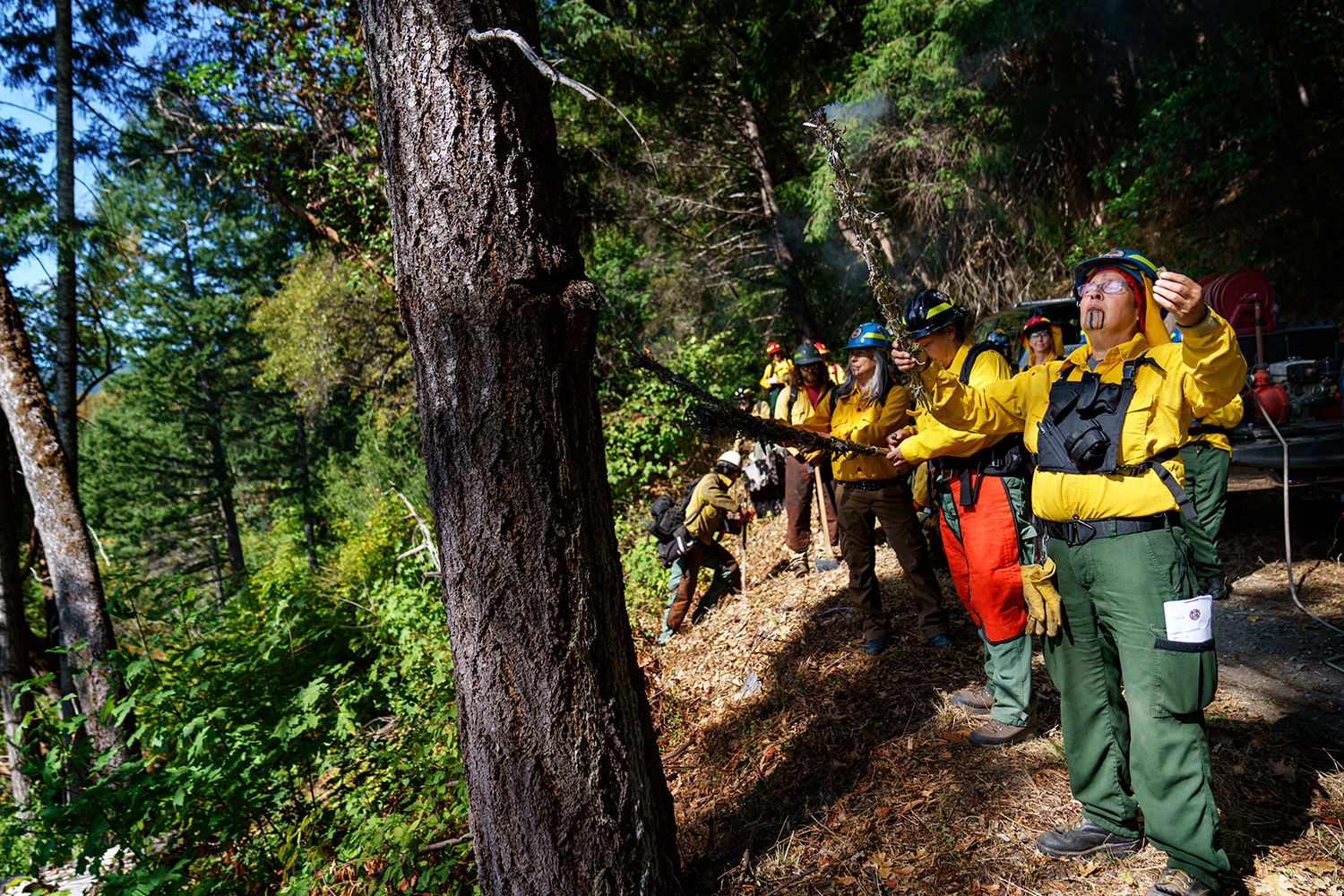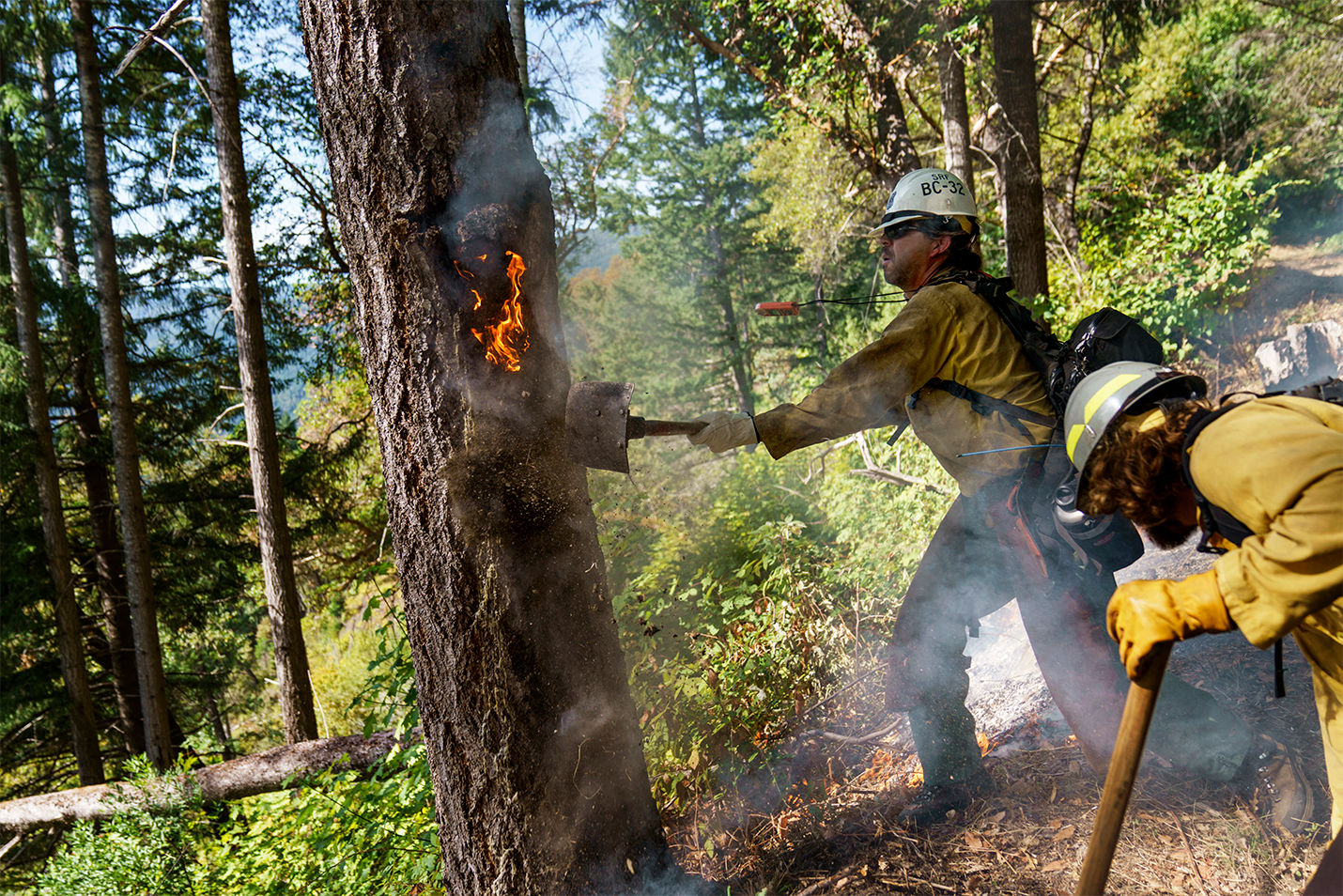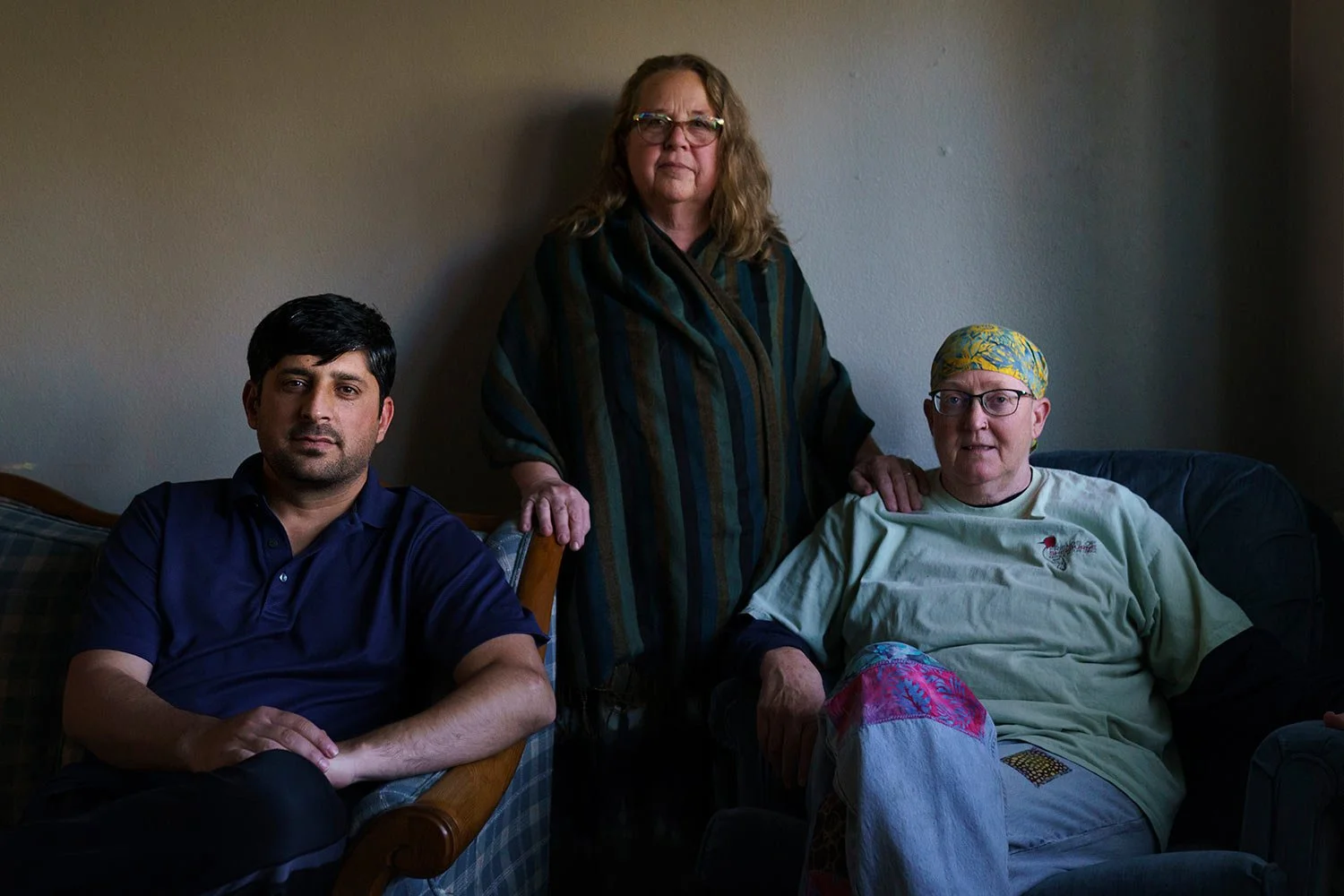For tribes, 'good fire' a key to restoring nature and people

Elizabeth Azzuz stood in prayer on a Northern California mountainside, arms outstretched, grasping a handmade torch of dried wormwood branches, the fuel her Native American ancestors used for generations to burn underbrush in thick forest.
“Guide our hands as we bring fire back to the land,” she intoned before crouching and igniting dead leaves and needles carpeting the ground.
Others joined her. And soon dancing flames and pungent smoke rose from the slope high above the distant Klamath River.
Over several days in early October, about 80 acres (32.4 hectares) on the Yurok reservation would be set aflame. The burning was monitored by crews wearing protective helmets and clothing — firefighting gear and water trucks ready. They were part of a program that teaches younger Yurok and other tribes the ancient skills of treating land with fire.
Such an act could have meant jail a century ago. But state and federal agencies that long banned “cultural burns” in the U.S. West are coming to terms with them — and even collaborating — as the wildfire crisis worsens.
Ancient wisdom and scientific research show otherwise, said Chad Hanson, forest ecologist with the John Muir Project of Earth Island Institute in California. Regulators are “trying to extort tribes” by making cultural burns contingent on logging, he said.
Bill Tripp, the Karuk tribe’s natural resources director, said the solution is empowering tribes to handle prescribed burns while Cal Fire and the Forest Service focus on suppressing wildfires.
The mid-Klamath area is ideal for a teaching center where cultural burners could “guide us into a new era of living with fire,” said Tripp, who learned from his great-grandmother and was setting small blazes in his remote village by age 8.
Tribes are uniquely positioned to train younger generations about stewardship-oriented fire management, said Scott Stephens, an environmental policy professor at the University of California, Berkeley.
“We’d need literally thousands of people doing this burning to ramp it up to a scale that’s meaningful,” he said.
Talon Davis, 27, a member of the Yurok crew, welcomed the opportunity “to show the world what good fire is.” He is Robbins’ son-in-law; his own toddler has been carried in her baskets, as she wished.
“This is how we’re supposed to care for Mother Earth,” he said. “Put fire back on the ground, bring our home back into balance.”
Talon Davis, 27, a member of the Yurok tribe, holds his son, Kenneth, 2, at the end of the day following a cultural training burn on the Yurok reservation in Weitchpec, Calif., Thursday, Oct. 7, 2021. Davis welcomed the opportunity "to show the world what good fire is." He added, "this is how we're supposed to care for Mother Earth. Put fire back on the ground, bring our home back into balance." (AP Photo/David Goldman)
Crews lay out hoses in preparation for a cultural training burn on the Yurok reservation in Weitchpec, Calif., Tuesday, Oct. 5, 2021. The burning was monitored by crews wearing protective helmets and clothing, firefighting gear and water trucks ready. They were part of a program that teaches younger Yurok and other tribes the ancient skills of treating land with fire. (AP Photo/David Goldman)
Water fills a holding tank set up by crew members preparing for a cultural training burn on the Yurok reservation in Weitchpec, Calif., Thursday, Oct. 7, 2021. To prepare for the one this month in the Klamath region, Yurok leaders studied weather forecasts, scouted mountainous burn areas, positioned water tanks, uncoiled fire hoses, equipped and drilled 30-plus crew members. (AP Photo/David Goldman)
Robert McConnell Jr, a prescribed fire specialist with Six Rivers National Forest and a member of the Yurok tribe, shovels dirt to put out a fire that climbed the bark of a tree during a cultural training burn on the Yurok reservation in Weitchpec, Calif., Thursday, Oct. 7, 2021. "I get to feel like I'm Indian again when I get to burn," he said. "It's encoded in my DNA. It's like there's a spark in my eye when I see fire get put on the ground." (AP Photo/David Goldman)
Lloyd Owens, a member of the Yurok tribe, carries a torch as he walks away from a hill he lit on fire during a cultural training burn on the Yurok reservation in Weitchpec, Calif., Thursday, Oct. 7, 2021. For thousands of years, Indigenous peoples set fire to clear forest floors of undergrowth. It supported foods such as acorns and hazel wood used in baskets. But starting in the early 1900s, federal policy made such activities illegal. That disrupted the tribes' hunter-gatherer lifestyle. And it built up fuels that feed wildfires. (AP Photo/David Goldman)
From left, Max Brotman and Rhodri Wiseman, rest along with Robinson Rancheria Pomo Indians Eric Timmons and his brother, Stoney Timmons, after they finished working a cultural training burn on the Yurok reservation in Weitchpec, Calif., Thursday, Oct. 7, 2021. (AP Photo/David Goldman)
Stoney Timmons, a member of the Robinson Rancheria Pomo Indians, smells a lemon balm plant while scouting an area with fellow participants of a cultural training burn in Weitchpec, Calif., Tuesday, Oct. 5, 2021. Before they were outlawed, cultural burns enriched the land with berries, medicinal herbs and tan oak acorns while killing bugs. It opened browsing space for deer and elk. It let more rainwater reach streams, boosting salmon numbers. It spurred hazelnut stems and bear grass used for intricate baskets and ceremonial regalia. (AP Photo/David Goldman)
Margo Robbins, a member of the Yurok tribe, holds a hazel leaf while scouting an area before a cultural training burn on the Yurok reservation in Weitchpec, Calif., Tuesday, Oct. 5, 2021. Tribes like the Yurok use baskets for gathering food and medicinal plants, trapping eels, ceremonial dancing, cradling babies, even prayer. But weaving materials had become scarce, particularly hazel wood. Burns in bygone days helped the shoots grow straight and strong. Under no-fire management, hazel was stunted by shrubs, downed trees, matted leaves. (AP Photo/David Goldman)
Jose Luis Dulce, center right, a firefighter in Ecuador and in his home country, Spain, listens during a briefing before a cultural training burn on the Yurok reservation in Weitchpec, Calif., Friday, Oct. 8, 2021. Dulce said he attended the training to help revive Indigenous techniques in Europe and South America. (AP Photo/David Goldman)
A scorched hillside rises from the backyard of Ruth, 72, and John Bain, 76, a member of the Karuk tribe, where last year's Slater Fire destroyed a house and several antique cars on their property in Happy Camp, Calif., Wednesday, Oct. 6, 2021. "They can get rid of the brush and that will save a bigger fire down the road, probably," said John. "It's gonna help because that's all going to come back in two or three years as just brush and if they can keep that under control, it could stop a big fire. I think the tribe should do it and the Forest Service should do it too." (AP Photo/David Goldman)
A woman fishes in the Klamath River as a mountain which burned in last year's Slater Fire stands in the background in Happy Camp, Calif., Wednesday, Oct. 6, 2021. Wildfires have blackened nearly 6,000 square miles (15,540 square kilometers) in California the past two years and more elsewhere amid prolonged drought and rising temperatures linked to climate change. Dozens have died; thousands of homes have been lost. (AP Photo/David Goldman)
ohn Bain, 76, a member of the Karuk tribe, walks by his prized 1954 Chevy five-window pickup that was destroyed in last year's Slater Fire which tore through his property and the Klamath National Forest in Happy Camp, Calif., Wednesday, Oct. 6, 2021. "I never seen winds like that. I never thought it would do what it did," said Bain. "I lost my little two-bedroom house and my shop, car port, a 40-foot cargo container, and the barn shed and I had four pick-ups that burned up." (AP Photo/David Goldman)
Text from AP News, For tribes, 'good fire' a key to restoring nature and people, by John Flesher.
Associated Press reporter Gillian Flaccus contributed to this story.
Photos by David Goldman
The Associated Press Health and Science Department receives support from the Howard Hughes Medical Institute’s Department of Science Education. The AP is solely responsible for all content.






